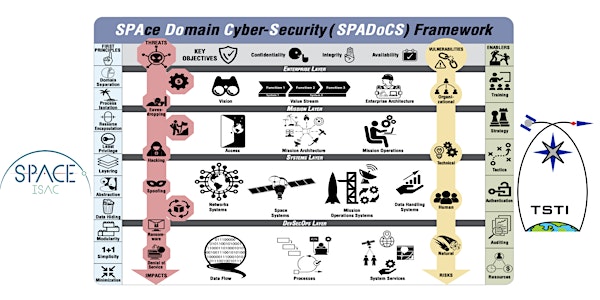
Space Domain Cybersecurity Course
A Systematic Approach using the SPAce Domain Cybersecurity (SpaDoCs) Framework
Date and time
Location
Online
Refund Policy
About this event
- 2 days 8 hours
This 3 day course will be held 8am-4pm MDT, March 5th - 7th.
Course Description:
This Space Domain Cybersecurity course examines the practical issues of developing and sustaining a secure cyber environment through all phases of the space mission lifecycle. The course is organized around the SPAce Domain Cybersecurity (SpaDoCs) Framework. The SpaDoCs Framework provides a comprehensive and systematic model for understanding and tackling all critical issues of cybersecurity in the space domain. An examination of the Key Objectives—confidentiality, integrity, availability—provides the foundation for the course. From there, the space domain is examined layer by layer starting from the enterprise layer, then drilling down through mission, system and DevSecOps layers. Threats and vulnerabilities at each layer are highlighted. Finally, first principles of cybersecurity are discussed (domain separation, process isolation, and others) as well as key enablers (such as vision and strategy) to help frame plans for action to address the cybersecurity issues exposed by this course. Course exercises center around practical application of the material to real- world space mission scenarios.
Course Objectives:
At the end of this course you should be able to...
- Describe the big picture challenges of cybersecurity in the space domain as organized in the SPAce Domain Cybersecurity (SpaDoCs) Framework
- List and define key objectives of cybersecurity (CIA Triad), the first principles of secure systems, along with cybersecurity enablers
- Identify cyber threats to and vulnerabilities of space missions and systems
- Characterize the various layers of the space domain and the elements that comprise them
- Apply cybersecurity first principles to specific space domain threats and vulnerabilities
- Associate specific cybersecurity enablers with various space domain threat or vulnerability scenarios
- Analyze threats and vulnerabilities and their attack vectors for various space domain scenarios at each layer
- Formulate inputs and issues to a cybersecurity assessment plan for a given space domain scenario
Course Topics:
• Course Intro
• Framework Overview
• Cybersecurity Fundamentals
• Space Domain Layers
- Enterprise Layer
- Mission Layer
- System Layer
- DevOps Layer
• Threats and Vulnerabilities
• First Principles of cybersecurity applied in the space domain
• Enablers of security and mission success in space enterprises
Who Should Attend:
• Cybersecurity professionals who want to understand the space domain
• Space professionals who want to understand the cyber domain
Course Materials:
• A complete set of course notes with copies of all slides used in the presentations.
Testimonials:
"Great explanations: Great diagrams for all the topics, including Cyber Kill Chain, how the Fire SAT system works, and Cyber concepts!"
"The introduction of space and cyber and the integration of the two was very clear. The domain layering model is great to give a perspective of thinking."
"Content and pacing are great. Seems perfect for a three-day course. I really enjoyed the space-specific content."
"I loved the teaching style. Both instructors were so knowledgeable and enthusiastic, it made the course really fun and easy to participate in. "
Your Instructors:
Dr. Bruce Chesley is an experienced space program manager and industry executive. He served as the Chief Strategist for a space system portfolio spanning human spaceflight, commercial satellites, and government space systems and he led the early development of a global broadband satellite constellation. He has also delivered advanced space systems and prototypes while serving in a variety of roles in program management, business development and engineering. His Air Force assignments included Air Force Space Command, the National Reconnaissance Office, and the USAF Academy where he was an Assistant Professor of Astronautics. He was elected to the International Academy of Astronautics in 2020 and serves as a Vice President on the Bureau of the International Astronautical Federation. He has published more than 20 technical papers and book chapters on satellite design and space systems engineering.
Terri Johnson is the Department Chair of the Computer Networking and Cybersecurity Department at Pikes Peak Community College. She has an MS in Cybersecurity and Information Assurance as well as over 20 years of experience in Information Technology, specializing in building and securing computer networks. Terri started out working for two of the world’s largest tax and audit firms, after which she transitioned to serving several educational institutions as both IT faculty and IT staff support. Terri is the lead faculty of the NSA-DHS designated Center of Academic Excellence program at PPCC; a member of WiCyS and the Colorado Springs chapter of ISSA (Information Systems Security Association), PPCC Cyber Club Advisor, and Coach to PPCC's nationally recognized Cyber Competition Team. Her industry certifications include Cisco's CCNA Routing / Switching and CCNA Security and EC-Council’s CEH (Certified Ethical Hacker). Terri is currently working on her DBA in Cybersecurity Management at University of Colorado, Colorado Springs.